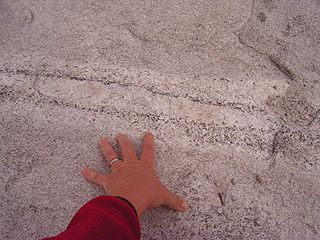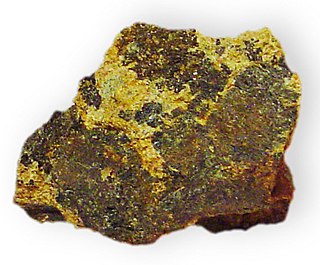
Talc, or talcum, is a clay mineral, composed of hydrated magnesium silicate with the chemical formula Mg3Si4O10(OH)2. Talc in powdered form, often combined with corn starch, is used as baby powder. This mineral is used as a thickening agent and lubricant. It is an ingredient in ceramics, paints, and roofing material. It is a main ingredient in many cosmetics. It occurs as foliated to fibrous masses, and in an exceptionally rare crystal form. It has a perfect basal cleavage and an uneven flat fracture, and it is foliated with a two-dimensional platy form.

Schist is a medium-grained metamorphic rock showing pronounced schistosity. This means that the rock is composed of mineral grains easily seen with a low-power hand lens, oriented in such a way that the rock is easily split into thin flakes or plates. This texture reflects a high content of platy minerals, such as micas, talc, chlorite, or graphite. These are often interleaved with more granular minerals, such as feldspar or quartz.

Amphibolite is a metamorphic rock that contains amphibole, especially hornblende and actinolite, as well as plagioclase feldspar, but with little or no quartz. It is typically dark-colored and dense, with a weakly foliated or schistose (flaky) structure. The small flakes of black and white in the rock often give it a salt-and-pepper appearance.

Magnesite is a mineral with the chemical formula MgCO
3. Iron, manganese, cobalt, and nickel may occur as admixtures, but only in small amounts.

Tremolite is a member of the amphibole group of silicate minerals with composition: Ca2(Mg5.0-4.5Fe2+0.0-0.5)Si8O22(OH)2. Tremolite forms by metamorphism of sediments rich in dolomite and quartz. Tremolite forms a series with actinolite and ferro-actinolite. Pure magnesium tremolite is creamy white, but the color grades to dark green with increasing iron content. It has a hardness on Mohs scale of 5 to 6. Nephrite, one of the two minerals of the gemstone jade, is a green variety of tremolite.

Metasomatism is the chemical alteration of a rock by hydrothermal and other fluids. It is the replacement of one rock by another of different mineralogical and chemical composition. The minerals which compose the rocks are dissolved and new mineral formations are deposited in their place. Dissolution and deposition occur simultaneously and the rock remains solid.

Blueschist, also called glaucophane schist, is a metavolcanic rock that forms by the metamorphism of basalt and rocks with similar composition at high pressures and low temperatures, approximately corresponding to a depth of 15–30 km (9.3–18.6 mi). The blue color of the rock comes from the presence of the predominant minerals glaucophane and lawsonite.

Ultramafic rocks are igneous and meta-igneous rocks with a very low silica content, generally >18% MgO, high FeO, low potassium, and are composed of usually greater than 90% mafic minerals. The Earth's mantle is composed of ultramafic rocks. Ultrabasic is a more inclusive term that includes igneous rocks with low silica content that may not be extremely enriched in Fe and Mg, such as carbonatites and ultrapotassic igneous rocks.

Cummingtonite is a metamorphic amphibole with the chemical composition (Mg,Fe2+
)
2(Mg,Fe2+
)
5Si
8O
22(OH)
2, magnesium iron silicate hydroxide.

Serpentinization is a hydration and metamorphic transformation of ferromagnesian minerals, such as olivine and pyroxene, in mafic and ultramafic rock to produce serpentinite. Minerals formed by serpentinization include the serpentine group minerals, brucite, talc, Ni-Fe alloys, and magnetite. The mineral alteration is particularly important at the sea floor at tectonic plate boundaries.

Anthophyllite is an orthorhombic amphibole mineral: ☐Mg2Mg5Si8O22(OH)2 (☐ is for a vacancy, a point defect in the crystal structure), magnesium iron inosilicate hydroxide. Anthophyllite is polymorphic with cummingtonite. Some forms of anthophyllite are lamellar or fibrous and are classed as asbestos. The name is derived from the Latin word anthophyllum, meaning clove, an allusion to the most common color of the mineral. The Anthophyllite crystal is characterized by its perfect cleavage along directions 126 degrees and 54 degrees.

Komatiite is a type of ultramafic mantle-derived volcanic rock defined as having crystallised from a lava of at least 18 wt% MgO. It is classified as a 'picritic rock'. Komatiites have low silicon, potassium and aluminium, and high to extremely high magnesium content. Komatiite was named for its type locality along the Komati River in South Africa, and frequently displays spinifex texture composed of large dendritic plates of olivine and pyroxene.

Greenschists are metamorphic rocks that formed under the lowest temperatures and pressures usually produced by regional metamorphism, typically 300–450 °C (570–840 °F) and 2–10 kilobars (29,000–145,000 psi). Greenschists commonly have an abundance of green minerals such as chlorite, serpentine, and epidote, and platy minerals such as muscovite and platy serpentine. The platiness gives the rock schistosity Other common minerals include quartz, orthoclase, talc, carbonate minerals and amphibole (actinolite).
The prehnite-pumpellyite facies is a metamorphic facies typical of subseafloor alteration of the oceanic crust around mid-ocean ridge spreading centres. It is a metamorphic grade transitional between zeolite facies and greenschist facies representing a temperature range of 250 to 350 °C and a pressure range of approximately two to seven kilobars. The mineral assemblage is dependent on host composition.

A metamorphic facies is a set of mineral assemblages in metamorphic rocks formed under similar pressures and temperatures. The assemblage is typical of what is formed in conditions corresponding to an area on the two dimensional graph of temperature vs. pressure. Rocks which contain certain minerals can therefore be linked to certain tectonic settings, times and places in the geological history of the area. The boundaries between facies are wide because they are gradational and approximate. The area on the graph corresponding to rock formation at the lowest values of temperature and pressure is the range of formation of sedimentary rocks, as opposed to metamorphic rocks, in a process called diagenesis.
A whiteschist is an uncommon metamorphic rock formed at high to ultra-high pressures. It has the characteristic mineral assemblage of kyanite + talc, responsible for its white colour. The name was introduced in 1973 by German mineralogist and petrologist Werner Schreyer. This rock is associated with the metamorphism of some pelites, evaporite sequences or altered basaltic or felsic intrusions. Whiteschists form in the MgO–Fe
2O
3–Al
2O
3–SiO
2–H
2O (MFASH) system. Rocks of this primary chemistry are extremely uncommon and they are in most cases thought to be the result of metasomatic alteration, with the removal of various mobile elements.

Listwanite (also sometimes spelled listvenite, listvanite, or listwaenite) is a rock type that forms when the groundmass of ultramafic rocks, most commonly mantle peridotites, is partially altered to carbonate minerals and cut by ubiquitous carbonate veins containing one or more of magnesite, calcite, dolomite, ankerite, and/or siderite. Original pyroxene and olivine in the peridotite are commonly altered to Mg- or Ca-carbonate and hydrous Mg-silicates, such as serpentine and talc. Complete carbonation of peridotite means that every single atom of magnesium and calcium as well as some of the iron atoms have combined with CO2 to form secondary carbonate minerals such a magnesite, calcite, and siderite, while the remaining silica atoms, formerly found in pyroxene and olivine (prior to alteration), are found in quartz, serpentine, and talc. Thus, in terms of bulk mineralogy, listwanites consist primarily of quartz (often of a rusty red colour), carbonate, serpentine, talc, ± mariposite/fuchsite (i.e., Cr-muscovite) ± gold.

Fenite is a metasomatic alteration associated particularly with carbonatite intrusions and created, very rarely, by advanced carbon dioxide alteration (carbonation) of felsic and mafic rocks. It is characterised by the presence of alkali feldspar, sodic pyroxene and sodic amphibole. Fenite alteration is known, but restricted in distribution, around high-temperature metamorphic talc carbonates, generally in the form of an aureole around ultramafic rocks. Such examples include biotite-rich zones, amphibolite-calcite-scapolite alteration and other unusual skarn assemblages. The process is called fenitization.
Mineral alteration refers to the various natural processes that alter a mineral's chemical composition or crystallography.

A subduction zone is a region of the earth's crust where one tectonic plate moves under another tectonic plate; oceanic crust gets recycled back into the mantle and continental crust gets created by the formation of arc magmas. Arc magmas account for more than 20% of terrestrially produced magmas and are produced by the dehydration of minerals within the subducting slab as it descends into the mantle and are accreted onto the base of the overriding continental plate. Subduction zones host a unique variety of rock types created by the high-pressure, low-temperature conditions a subducting slab encounters during its descent. The metamorphic conditions the slab passes through in this process creates and destroys water bearing (hydrous) mineral phases, releasing water into the mantle. This water lowers the melting point of mantle rock, initiating melting. Understanding the timing and conditions in which these dehydration reactions occur, is key to interpreting mantle melting, volcanic arc magmatism, and the formation of continental crust.
















